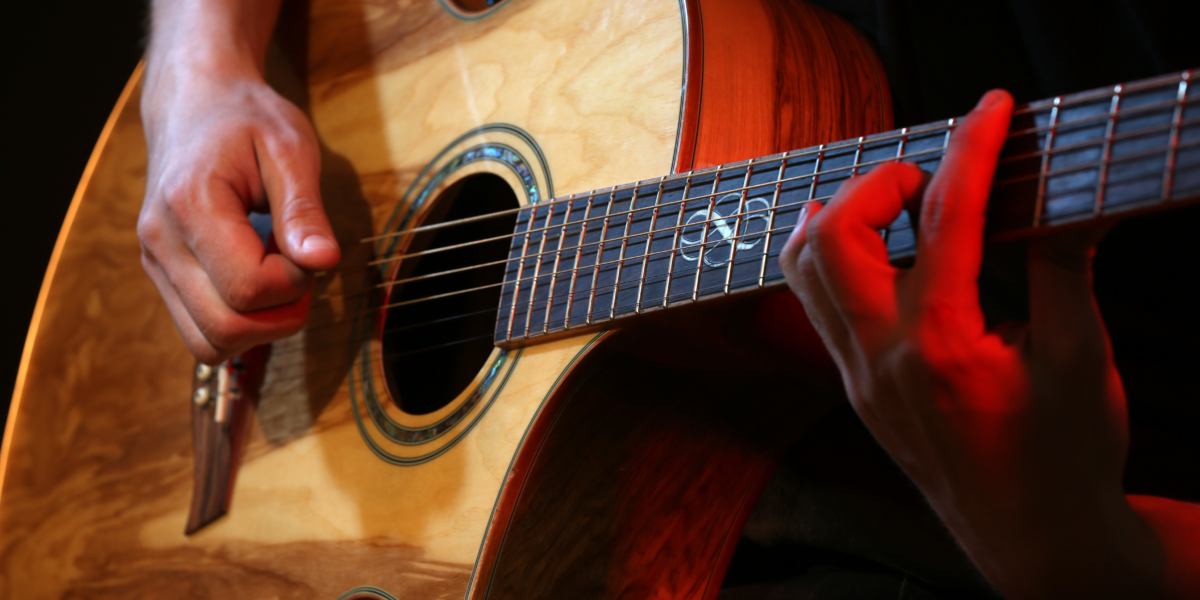The Ultimate Guide to Play Rhythm Guitar (2022)

What is a rhythm guitar? How can you learn how to play it? Where do you start? Find out all the answers in this beginner’s guide.
The guitar is a dynamic instrument that can fulfill many musical roles. You may have an inherent affinity for a particular style, depending on your preferences. Rhythm guitarists play an essential part in creating a song’s tempo and overall sound.
However, regardless of the guitar you want to use, the skills you develop as a rhythm guitarist will boost your overall skill level.
So get into the flow and learn all you need to start playing rhythm guitar.
What is a rhythm guitar?
When playing in a band, musicians work together to create music. Through timing and skillful cooperation, you collectively create and combine the various elements of a song.
One of those roles is maintaining the rhythm of a song. In a band, several instruments do this; depending on how many guitarists there are, one may devote themself to keeping rhythm.
Rhythm guitarists possess essentials skills like:
- Ability to play and transition chords
- Proficiency in strumming patterns
- A sense of timing
- An understanding of basic music theory
The importance of rhythm.
The rhythm of a song refers to a strong, regular, repeated movement of sound. Rhythm creates a tempo and groove which moves the piece forward.
For people not familiar with music theory, songs can seem beautifully chaotic. Rhythm governs the song, providing lead instruments and vocals to play and sing around.
Instruments like the bass, drums (and other percussion instruments), and guitar dictate the song’s rhythm.
How to play your first guitar rhythm.
Learning how to play rhythm guitar begins with understanding tempo. You can think of the tempo as a song’s heart rate.
In music, we time the pulse by counting notes. In a given bar, a basic music piece has four quarter notes, two half notes, or a single whole note.
At first, counting on your own can overcomplicate your practice. You can always use a metronome to help you maintain a tempo too. By setting the speed, the metronome ticks at an even pace, so you can focus on playing.

But don’t rush to the store to buy one. Simply Metronome is a free metronome app that’s easy to use.
In a bar, a whole note will span a count of 1-2-3-4 beats or ticks of the metronome. Meaning you play a single note or chord that lasts four beats. You can divide a whole note into half notes, so you play two notes across four beats.
The subdividing continues into quarter notes, eighth notes, and sixteenth notes.
Easy chords
Before getting into counting, it’s essential to learn some basic chords. Playing rhythm guitar is impossible without knowing chords. Practice playing and transitioning between chords like:
- C major partial
- A minor partial
- G major partial
- E major partial
- C major
- A minor
- G major
- E major
Once familiar with some chords, you can start practicing them at different tempos.

Counting quarter notes
Quarter notes are the most common note value. Each note lasts for one beat. An easy way to practice rhythm is to get your metronome out and set it to a moderate speed. 80 beats per minute (bpm) is a starting pace.
- Pick a whole note and play it for every count.
- Once you have that down, add a second note and play both notes for two counts.
- Continue the pattern until you reach four notes.
- Once you have single notes down, try it with some chords.
When practicing, you can also adjust the bpm or your metronome to make things easier or more challenging.
It can feel tedious at first. However, these are vital steps to take as a beginner rhythm guitarist. Besides, this is just the first step.

Counting Eighth Notes
Once you’re comfortable with quarter notes, it’s time to take your training to the next level with eighth notes.
There are two eight notes in a quarter note, four eight notes in a half note, and eight eighth notes in a whole note. We count eight notes like this:
1-&-2-&-3-&-4-&
The ‘&’ refers to an off-beat, and the numbers refer to an on-beat, leading us to strum patterns.
Easy strumming patterns
While strumming may seem easy, it can be complex. Many hit songs only use three to four chords for rhythm. Pink Floyd’s “Wish You Were Here” uses four chords, but the rhythms change a lot throughout the song.
Perfecting your strumming patterns is vital whether you’re a lead or rhythm guitarist. As you progress, you can play around with your strumming patterns. For now, try playing these:
- 1& (↓) 2 (↓) & (↑) 3& (↓) 4 (↑) & (↓)
- 1& (↓) 2& (↓) 3 (↓) & (↓) 4 (↑) & (↓)
- 1& (↓) 2& (↓) 3 (↑) & (↓) 4 (↑) & (↓)
While you play these strumming patterns, practice counting with your foot, and bring your foot down for the on-beat and up for the off-beat.
At first, practicing strumming patterns with a single chord is simpler. Once you’re playing the patterns smoothly, add another chord, etc.
Common rhythm guitar beginner mistakes.
Learning a new skill is challenging and exciting. There’s a ton of learning; in most cases, beginners can’t fully conceive all of the aspects of the journey.
As you embark on your learning endeavor, there are a few mistakes to avoid.
- Only practicing rhythm guitar. As a beginner, it’s hard to know what to expect and what you’ll prefer to do. Many guitarists a proficient in both styles, so don’t focus purely on lead or rhythm.
- Racing to get to the next level. Being eager to learn is fantastic. Although, taking your time at the stage you’re at and properly learning the lesson sets the foundation for the next stage.
- Giving up. Starting anything new is overwhelming at first. Being patient is crucial. Sometimes developing a skill or achieving a goal takes time–it always takes persistence.
5 tips to play rhythm guitar.
- Familiarize yourself with some time signatures. Start with something simple. Find some 4/4 songs and listen carefully. The more you can find and follow the tempo, the more intuitive playing to one will be.
Not sure what time signatures are? Learn about them in our blog, How to Play Music in a 4/4 Time Signature.
- Practice regularly. There’s a lot to take in when it comes to playing guitar.
- Break your lessons down. Devoting time to each part of playing rhythm guitar makes combining everything smoother.
- Listen to music. As you learn about music theory, you’ll notice it more and more in the songs you listen to. Hearing the nuances of off and on-beats, identifying notes, and strumming patterns become food for your mind.
- Enjoy. Once you’ve got a handle on the basic chords and strumming techniques, start practicing along with your favorite songs.
Go with the flow.
The guitar is a dynamic instrument that can serve various purposes. Regardless of the genre of music you play or the role you’re fulfilling in a band, many aspects of rhythm are essential for all musicians.
At Simply, we devote ourselves to teaching people how to play their favorite instruments by providing them with useful information and equipping them with quality tools. Simply Guitar is an app that offers fun, bite-sized lessons for rhythm and lead guitarists alike! Give it a try today.









